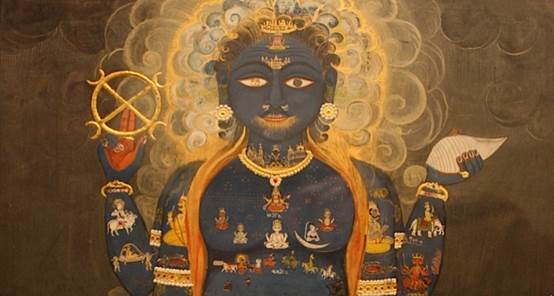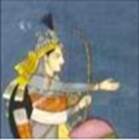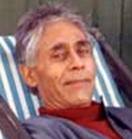
Free Will / Part III: Bhagavad Gita XVIII.61
The Lord of all beings abides in the Heart,
Causing all beings to wander, to move (to revolve),
[As if] fixed, attached to, mounted on a machine,
By the power of Illusion (maya).
ishvarah sarvabhutanam
hriddeshe Arjuna tishthati
bhramayam sarvabhutani
yantrarudhani mayaya
The Bhagavad Gita reflects many paradoxes, seeming contradictions, which I
believe are always relative to the particular state of consciousness we are in
when we read this brilliant enlightening text. Our comprehension of the sage
Vyasa's Gita is always changing, moving toward a deeper understanding with each
reading. That is its magnificence, its timeless greatness beyond language,
custom and borders. We perceive life quite differently when we are in a state of
feeling separate from the One, but when we become immersed in God-Consciousness
no contradictions exist. As Swami Lakshmanjoo has said, when we reach the state
of Parabhairava, “All questions disappear!”

The Wheel of Action
Lokamanya Bal Gangadhar Tilak (1856-1920) a mathematician, astronomer,
historian, journalist, philosopher, and political leader, was considered to be a
spiritual and intellectual giant. He was also a political activist, an advocate
of 'Swaraj' (self-rule for India), the first popular leader of the Indian
Independence Movement, and deeply committed to the idea of lokasamgraha, working
for the well-being of the world, universal welfare. He was called the 'Father of
the Indian unrest' by the British colonial authorities [wiki].
In 1908, the British government convicted Tilak of sedition for defending
violent revolutionary acts and Tilak was sent to the Mandalay prison in Burma.
He wrote his commentary on the Bhagavad Gita while he was in jail. Tilak’s ‘Gita
Rahasya’ (the Esoteric Import of the Bhagavad Gita) was originally written in
Marathi, over 1000 pages with a lead pencil. Many copies of the book were sold
and the profits donated to freedom fighting. Tilak also wrote 'The Arctic Home
in the Vedas' which used evidence in the Rig Veda to propound the theory that
the North Pole was the original home of the sages who composed the Vedic Hymns.
Regarding the meaning of the
yantrarudhani in verse 61 above, B.G. Tilak has said that we have “no
control over the Wheel of Action, which has been moving from times immemorial.
Even if we may not wish them, nay, even if we may wish otherwise, hundreds and
thousands of things are going on in the world…the wise man performs these
Actions, keeping his mind pure, and looking upon pain and happiness as alike —
whereas, the fool gets entangled in the bonds of those Actions.” Tilak quotes an
earlier verse [BhG.III.33] in which Krishna states that we are all bound to our
own unique material nature (prakritim), the gunas, and nothing will restrain,
control or suppress our innate compulsions. J.A.B. van Buitenen translates
Krishna’s words what I believe is gentle wry humour as, “Who will stop them?”
Tilak expresses his view on the question of Free Will by saying that verses 61 &
62 give credit for all Acts to the Ishvara, the One. “All activities, which go
on in the world, are got done by the Parameshvara [Para means highest] just as
he wants them to be done.” Therefore we find our best and highest recourse is to
simply surrender all our thoughts and actions to the God-within, the Oneness
that permeates All — because there is nothing that is not the One. What we do
and think, our desires and possessions belong to the One Source anyway, so what
are we really in fact surrendering? We are surrendering our ignorance, our
misconception of the primordial metaphysical Real. It is only this Veil of
Ignorance and Delusion that keeps us in the ‘apparent’ perception that we are
separate. We are not, we never were, and never will be.
Tilak continues by saying what he feels to be the true meaning of verse 63,
wherein Krishna tells Arjuna, 'Do as you please!'
“…when you have Realized this Knowledge, you will be self-enlightened; and
thereafter (not before), whatever Action may be voluntarily performed by you,
will be consistent with morality, and correct; and when you have thus reached
the state of a Sthitaprajna (calm, firm in judgement & wisdom, contented), it
will no more be necessary for you to control your Desire.”

'Similitude' with God
When we are in harmony and alignment with the Creator, having surrendered our
Ignorance and Delusion, as K.K. Nair would say when we have reached 'similitude'
with God, then whatever we do, whatever we Desire will be in equilibrium with
that which is the substratum of this temporal holographic polarity universe.
Devotion to the One is the key to surrender, and therefore Devotion, Bhakti
Yoga, the sacred profound Love of God is given a higher place in the Bhagavad
Gita. Loving God is the fast lane Home.
Yantrarudhani
is described in a translation by Swami Gambhirananda (Advaita Ashrama in the
Himalayas) as: “just like a magician who revolves the totally non-independent
wooden human forms etc. seated on a machine etc. moved by a rope.” This
description brings to mind the idea of robots or even virtual reality, entities
that are powerless without their creators and controllers. The conclusion is
made that until we take Refuge in the God-within with our whole being and in a
state of Grace, attain Knowledge, supreme Peace and the eternal state of
Oneness, all human efforts are useless.

Neuroplasticity and changes in the brain
In his revealing book 'The Shallows' Nicolas Carr describes how and why the
Internet is changing our brains. The Internet is the latest tool that throughout
history has "shaped the physical structure and workings of the human mind. Their
[tools] use has strengthened some neural circuits and weakened others,
reinforced mental traits while leaving others to fade away."
As Carr says even though the brain itself hasn't changed much in the last 40,000
years, history shows that the ways human beings think and act have.
Recent insights into neuroplasticity - the changes in neural pathways and
synapses which are due to changes in behaviour, environment and neural processes
- have demonstrated that "Through what we do and how we do it...we alter the
chemical flows in our synapses and change our brains." These changes are in turn
passed on to our children through their schooling and in our DNA.
Carr even mentions writing as a tool that changed humankind, which I found
particularly interesting because writing is a symptom - like an illness - of the
Kali Yuga. The process of learning to read and write alters our brain patterns.
Carr quotes a 4th century BC Egyptian king as saying, "Should Egyptians learn to
write, it will implant forgetfulness in their souls: they will cease to exercise
memory because they rely on what is written, calling things to remembrance no
longer from within themselves, but by means of external marks." The king goes on
to say that people will appear to know a great deal, but this quantity of
knowledge is in fact bereft of wisdom, and is only the "conceit of wisdom" —
thus they know nothing.
I wonder how many of us have understood the consequences of surfing the
Internet, reading dozens of articles in a superficial rapid-fire shallow state
of focus. The ancient Sanskrit texts were handed down from memory 'smriti' for
1000s of years. Who would be capable of memorizing hundreds of pages of text
today? Perhaps this is the real reason for the ancient wisdom schools methods of
attaining Knowledge, the daily reading of sacred texts, certain prescribed
behaviours that build purity, and simplicity in our every day lives. Our freedom
to choose what we put in our brains, meaning how we program the neuroplasticity
in our individual brains, is the key to Liberation (Moksha). Perhaps our one
true Free Will is the choice we possess to create a consciousness of purity, and
in loving peaceful silence move towards a return Home.

Chapter IX, verses 7 & 8 in the Bhagavad Gita expresses another rather shocking
perplexing statement of humanity’s helplessness in the matter of Free Will.
7.
All beings, Arjuna (son of his mother Kunti),
Into My [the One] own material nature, they go
At the end of a kalpa (Day of Brahman, 4,320,000,000 years).
Again at the beginning of a kalpa, I send them forth.
sarvabhutani kaunteya
prakritim yanti mamikam
kalpakshaye punas tani
kalpadau visrijamy aham
8.
Supported and resting on My material nature,
I send forth again and again
This entire multitude of beings,
Who are powerless, by the Will of My material nature.
prakritim svam avastabhya
visrijami punah punah
bhutagramam imam kritsnam
avasham prakriter vashat
J.A.B. van Buitenen translates verse IX.8 as “…I create, again and again, this
entire aggregate of creatures involuntarily by the force of My nature.” We have
no choice. According the van Buitenen, the Sanskrit words
prakriter vashat imply that “this
inherent creative and destructive pulsation of God is automatic."
Boris Marjanovic’s translation is a bit different in flavour: “All beings at the
end of one cycle pass into Prakriti, which is My own; and once again, at the
beginning of the next cycle, I create them forth.” Marjanovic says that
Abhinavagupta took the word Prakriti here to mean
avyaktam, the unmanifested. Because
all creatures are under the control of the Lord’s unmanifest, bound in
Prakriti's gunas and five-sense perception, they are powerless. However,
Abhinavagupta comments that by assigning the creatures and objects of the world
to the unmanifested Prakriti, “in spite of being unconscious by nature, become
illuminated by the light of consciousness, which belongs to the highest
reality.” This implies that in spite of our powerlessness and temporal state of
unconsciousness, we are still the One — and "illuminated by the light of
consciousness" we can always therefore reach our Source, That which we are.

‘We can do anything in this world.'
Swami Lakshmanjoo’s translation of Abhinavagupta’s Gita translates Prakriti as
Maya and his comment reveals that after the big Pralaya (the Dissolution of a
Kalpa), “They sleep for one night [of Brahma] and then wake up and are again
caught by repeated births and deaths in samsara, and in this way, the whole
universe goes on. It is never ending.” And again in Abhinavagupta’s
understanding, Swami Lakshmanjoo says, “I [the Lord] am the creator of this
whole universe. I create this whole universe [by] taking hold of My nature,
prakriti. I adjust [My] prakriti in individuals and that [para, meaning highest]
prakriti becomes apara prakriti [the manifested material nature, meaning the
five great elements, along with mind, intellect and ego] there in individuality.
But in real sense, that apara prakriti is one with that para prakriti of Mine…
This is why individuals have this understanding in their nature that, ‘we can do
anything in this world.’ (from 1978)”
Intractable dualisms
The polymath savant K.K. Nair/Krishna Chaitanya believed that the author of the
Bhagavad Gita, Vyasa was convinced that life was meaningful. K.K. Nair says, “If
existence has a goal, it does not flow towards it smoothly, easily; it has to
fight its way through endless obstructions. This struggle is what gives life its
drama; but when one seeks to account for its origin, one confronts intractable
dualisms.” God’s dynamism lies in morphing shifting reappearing mystery,
koan-like contradictions, and unruly intractable dualisms.
Prakriti’s material nature as the shakti-power that generates this temporal
illusory holographic universe is dependent on the One that is the substratum of
All. As the mirrored reflections of the One, we are the ‘entire multitude of
beings’ that are sent forth powerless again and again — it is we who are the
precious selves of the Oneness, we are ‘dear’ and indeed the joyful reason for
Life itself. K.K. Nair quotes the poet Rilke, “What will you do God, when I die?
...in losing me you lose your meaning.” And also quotes Ibn al-Arabi
(1076-1148), the Sufi poet of Spain, “God is necessary to us in order that we
may exist, while we are necessary to Him in order that He may be manifested as
Himself.”

All would be meaningless...
Swami Muni Narayana Prasad has a beautiful way of expressing this idea in his
superbly terrific translation of the Mundaka Upanishad:
“What makes life beautiful and worth living is these two aspects of
consciousness [meaning the God-within as observer and us as the living Beings
enjoying five sense perception], always inseparable, one meaningless without the
other. In the absence of life, the existence of the self, self-enquiry and even
the existence of God, would all be meaningless…”
Believe me, I know that at times this world seems to be only a heartless, cruel,
terrifying, blood thirsty, and stupid pointless place. Is there even one honest
man with integrity left in positions of power these days? I have thought that
this hopeless feeling may be natural as we approach the end of this cycle of
time, or even as perhaps some have grown weary of the ‘Play’ of the Divine Lila.
We find ourselves disinterested in the game, we have seen it all so many times,
and want nothing more than to find our way Home.
The ancient metaphysical school Samkhya compares Prakriti to a dancer who has us
enchanted, absorbed, deceived and hypnotized by her seductive mesmerizing
movements. But as time passes, we realize that she is acting, her dance in not
the Real — it is only a temporal Play, a performance. When she feels that her
act has been 'seen', that she is no longer able to entice, beguile and delude
her audience, she simply stops dancing. And we stop being caught in her
spellbinding show.
The Samkhya Karika: [When ignorance is dispelled] “…there is nothing else left
to be produced by Prakriti…[we] lose all interest...[and she] Prakriti thinks,
‘I have been seen’ and therefore ceases to act further. Therefore even if there
is still connection, there is no motive for further evolution…with the absence
of this bondage, enjoyments also cannot be there…the connection of the Spirit
with Prakriti ceases, and it does not behove the spirit to crave anymore for the
objects of the senses.” She stops her performance.

"...indeed if it can be known at all."
The eternal mystery that is God, the ubiquitous Oneness, will always elude us.
The Rig Veda Rishi Visvamitra, the Sage who composed hymn X.129, wondered if the
Creator can ever be known: "We
know not if it can be held, the continuum - indeed if it can be known at all."
Just as we imagine we may have succeeded in approaching any complete knowledge
of the imperishable, immutable One — that very fragmentary aspect of Its
infinite Being will shift, vaporize into yet another mirage-like no-form form.
The One is forever morphing into never ending myriads of appearances, that we as
Its mirrors reflect.
When we become still, quiet and rest in the Peace that surpasses all
understanding, and are at last able to listen and merge into our true Self, then
the hope of Truth Satya returning to this lovely blue-green planet, our Beloved
Mother Earth will again emerge and shine. The Oneness is Love, the ultimate
unified field — and that divine and eternal Love is always available to us, to
restore and renew our Being, if we so choose to drink from the overflowing Cup
in the Heart.
We meet in the Heart,
V. Susan Ferguson

Sources:
Sri Bhagavadgita-Rahasya or Karma-Yoga-Shastra, (Including an external
examination of the Gita, the Original Sanskrit stanzas, their English
translation, commentaries on the stanzas, and a comparison of Eastern with
Western doctrines, etc.), by Bal Gangadhar Tilak, translated by BH Alchandra
Sitaram Sukthankar; Published by Tilak Brothers, Kesari Press, Pune, 1926, 2004.
Bhagavad-Gita with the annotation Gudhartha-Dipika, by Madhusudana Sarasvati,
translated by Swami Gambhirananda; Advaita Ashrama, Calcutta, 1998, 2000.
The Shallows, What the Internet is Doing to Our Brains, by Nicholas Carr; W.W.
Norton & Company, NY, 2010, 2011.
Mundaka Upanishad, with original text in Sanskrit and Roman transliteration,
Translation with a [brilliant illuminating!] Exhaustive Commentary by Swami Muni
Narayana Prasad; D.K. Printworld, New Delhi, 1998.
Samkhya Karika of Ishvara Krishna, Translated by Swami Virupakshananda; Sri
Ramakrishna Math, Madras, 1995. [Available as an online PDF.]
Bhagavad Gita, In the Light of Kashmir Shaivism, with original video, Revealed
by Swami Lakshmanjoo, Edited by John Hughes, Co-editors Viresh Hughes and Denise
Hughes; Universal Shaiva Fellowship, 2013.
The Gita for Modern Man, by Krishna Chaitanya; Clarion Books, Associated with
Hind Pocket Books, New Delhi, 1986, 1992.
KRISHNA CHAITANYA, A Profile and Selected Papers; Edited by Suguna Ramachandra;
Konark Publishers Pvt. Ltd., Delhi, 1991.
Life’s Pilgrimage Through The Gita, by Swami Muni Narayana Prasad; D.K.
Printworld, New Delhi, 2005, 2008.
The Bhagavad Gita in the Mahabharata, A Bilingual Edition, translated by J.A.B.
van Buitenen; The University of Chicago Press, 1981.
The Bhagavad Gita, translated by Winthrop Sargeant; State University of New York
Press, 1994.
Abhinavagupta’s Commentary on the Bhagavad Gita, Gitartha Samgraha, translated
by Boris Marjanovic; Indica Books, Varanasi, 2002, 2004.
| Questions
or comments about articles on this site: Email V. Susan Ferguson: Click Here |
Copyright© V. Susan Ferguson All rights reserved. |
Technical questions or
comments about the site: Email the Webmaster: Click Here |